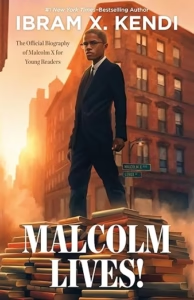Malcolm Lives!: The Official Biography of Malcolm X for Young Readers
Ibram X. Kendi
Farrar, Straus, & Giroux
Published May 13, 2025
Amazon | Bookshop | Goodreads
About Malcolm Lives!: The Official Biography of Malcolm X for Young Readers
In collaboration with the Malcolm X Estate, this powerful biography for young readers is a modern classic in the making, written by #1 New York Times-bestselling, National Book Award-winning author Ibram X. Kendi.
Published 100 years after his birth, Malcolm Lives! is a ground-breaking narrative biography of one of the most influential Americans of all time.
Dr. Kendi expertly crafts a propulsive telling of Malcolm X’s life—from birth to death. He provides context for both Malcolm’s choices—and those around him—not just painting an intimate picture of a famous figure, but of the social and political landscape of America during the civil rights movement. Ultimately, Malcolm’s true legacy is a journey toward anti-racism. Just like history, Malcolm lives.
With short, evocative chapters, exclusive archival documents, photographs from the Malcolm X Collection at the NYPL Schomburg Center, and extensive backmatter, this is a thoughtful and accessible, must-read for all Americans.
My Review
I feel like my history textbooks never gave the appropriate amount of space to Malcolm X, his life, and his work. I suspect that some of that has to do with the fact that his message was a lot more challenging, especially for white Americans. At times, he was very clear that he had nothing to say to white America. For much of his life, he saw his mission, his calling as being to Black America.
This book doesn’t only relate Malcolm X’s life story from beginning to end. It also offers some context for the choices he made. At certain points, Dr. Kendi asks readers directly to consider the facts of history. He asks reader to think beyond what happened in one moment of Malcolm X’s life, but to look at the pattern of history before his life and since.
Some of the story follows Malcolm X’s life as a member of the Nation of Islam. I think the book explains the goals of the organization and their values really well. It also discusses where the leaders fell short of the values they preached. Dr. Kendi offers some thoughtful critique and, again, some historical context that will help readers place these events in the larger arc of history. He also emphasizes some of the reasons it’s important to know this history.
Conclusion
Earlier this year, I read a biography of Dr. Martin Luther King, Jr. by Jonathan Eig. It’s interesting thinking about the lives of these two men, who lived through many of the same moments in history. They had very different experiences and different ideas about what the best path forward for Black Americans would be. I think reading both books or at least learning about both leaders is something that we should all be doing. Malcolm Lives! does a great job educating readers about Malcolm X’s life and his work in America.
Content Notes
Recommended for Ages 10 up.
Profanity/Crude Language Content
None.
Romance/Sexual Content
References to marriage and dating relationships.
Spiritual Content
The book explains the establishment and history of the Nation of Islam and its teachings. Some brief explanations delve into the difference between the teaching of the Nation of Islam and the Islamic faith.
Violent Content
References to racist violence, lynching deaths, destruction of property, attempted murder, murder, and police brutality. Some reference to self-defense. These things are not described in any detail and are mentioned in the context of history. For example, the narrative discusses how someone set fire to Malcolm X’s house when he was a young child, and how it happened again while he was an adult, and that triggered those childhood memories. The author also draws a parallel between the police response to both crimes.
Drug Content
References to smoking cigarettes and using drugs. Nothing shown graphically. This also shows how seriously Malcolm X took his faith, because he stopped smoking or using drugs when he joined the Nation of Islam and later converted to Islam.
Note: This post contains affiliate links, which do not cost you anything to use but help support this blog. I received a free copy of this book in exchange for my honest review. All opinions are my own.
